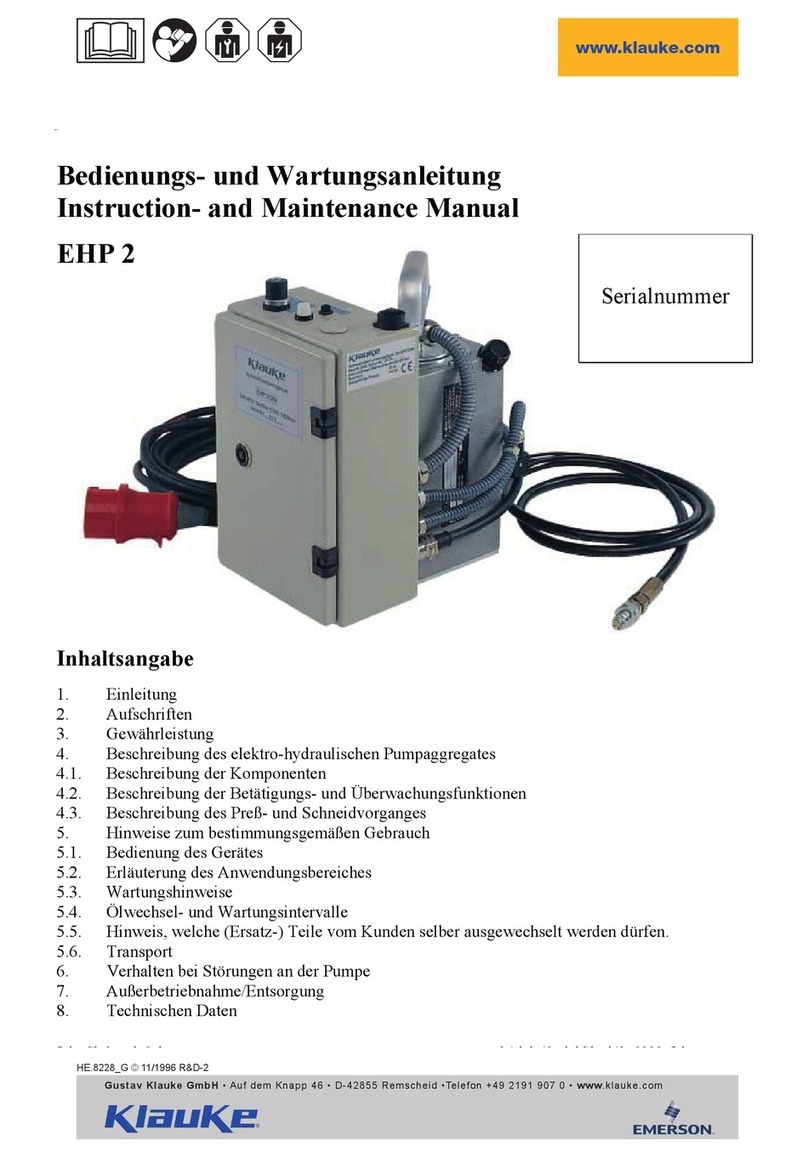
Bedienungsanleitung
EHP4230
2
D
HE.12929_E © 05/2011
Zum Einrichten der Pumpe wird das Gehäuse unter Ver-
wendung des im Lieferumfang befindlichen Schlüssels
geöffnet. Die Einstellung z.B. der Kolbenvorschubge-
schwindigkeit oder auf die jeweiligen Lochstanzeinsätze
erfolgt durch Drehen des Steuerungswahlschalters auf
die Position ‚Einrichten’ bei gleichzeitiger Justierung der
Stellknopfes (Bild 1.3) auf den in der Tabelle vorgeschrie-
benen Wert.
Desweiteren verfügt die Pumpe über einen Betriebswahl-
schalter (Bild 1.12) für die Auswahl des Betriebszustan-
des, z.B. Normalbetrieb, Rücklaufstopp und Stanzbe-
trieb.
Betriebszustand Beschreibung
Normalbetrieb Kolben läuft nach Loslassen des
Sicherheitsfußtasters in die Aus-
gangsstellung zurück.
Rücklaufstopp Kolben verharrt nach Loslassen des
Sicherheitsfußschalters in der er-
reichten Position. Nach nochmaliger
Betätigung wird der Arbeitsvorgang
fortgesetzt.
Stanzbetrieb Der Stanzvorgang besteht aus
einem Schnellvorschub und einem
Schleichgang.
Der Druckaufbau kann jederzeit an einem an der Pumpe
auf Wunsch angebrachten Manometer verfolgt werden.
3.3.1Beschreibung des Preß- bzw. Schneidvor-
ganges
Beim Preßvorgang werden die Werkzeugeinsätze gegen-
einander gefahren. Der auf das Kabel aufgeschobene
Kabelschuh/Verbinder befindet sich bei geschlossenem
Preßkopf in der feststehenden Hälfte des Preßeinsatzes.
Der auf der Kolbenstange sitzende bewegliche Teil des
Preßeinsatzes bewegt sich dabei auf die Preßstelle zu.
Eine Pressung ist abgeschlossen, wenn die Werkzeugein-
sätze vollständig zusammengefahren sind.
Weitere Hinweise zur Verpressung von Verbindungsma-
terialien entnehmen Sie bitte unserem Montagehinweis
im Katalog.
Bei Schneidvorgängen nach dem Scherenprinzip wird
das Kabel in die geöffneten Schneidbacken des Schneid-
kopfes eingelegt, bzw. der Schneidkopf so an das Kabel
angelegt, sodaß sich die Lage des Schneidkopfes wäh-
rend der gesamten Schneiddauer nicht ändert.
Um ungünstige Scherwirkungen zu vermeiden müssen
die Scheren immer lotrecht auf das zu schneidende Ka-
bel zufahren.
Bei dem Scherenprinzip bewegen sich zwei Messer
gleichzeitig auf das zu schneidende Kabel zu.
3.3.2Beschreibung von Stanzvörgängen
Ein Stanzvorgang wird gekennzeichnet durch das Einzie-
hen des Stempels in die Matrize. Dazu muß der Stempel
bis an das Blech herangeschraubt werden.
Der Stanzbetrieb ist gekennzeichnet durch 2 Geschwin-
digkeiten, einen schnellen Stanzbetrieb und einen lang-
samen Schleichgang. Nach Beendigung des Stanzvor-
ganges schaltet die Pumpe in einen sehr langsamen
Schleichgang um eine Zerstörung von Stempel und Ma-
trize durch ungewollte Kontaktierung von Stempel und
Matrizenboden zu verhindern. Hierbei handelt es sich um
eine Komforteinstellung.
3.3.3Beschreibung von Biegevörgängen
Der Betriebszustand mit Rücklaufstopp eignet sich be-
sonders für den Betrieb des Stromschienenbiegegerätes
in Verbindung mit dem Näherungsschalter.
Im Rücklaufstoppbetrieb kann der Arbeitshub in jeder Po-
sition unterbrochen werden ohne dass der Kolben in die
Ausgangslage zurückfährt. Bei nochmaliger Betätigung,
z.B. des Handtasters des Stromschienenbearbeitungs-
zentrums, wird der Arbeitszyklus an dieser Stelle fortge-
setzt. Durch eine sehr kurze Betätigung des Handtasters
kann der Kolben im Fehlerfall in die Ausgangsstellung
zurückgefahren werden.
Für weitere Hinweise lesen Sie bitte die Bedienungsanlei-
tung des Stromschienenbiegegerätes.
4. Hinweise zum bestimmungsgemä-
ßen Gebrauch
Es muß darauf geachtet werden, daß das Pumpaggregat
standsicher auf einer ebenen Fläche mit einem maxima-
len Neigungswinkel von 15° aufgestellt wird.
4.1 Bedienung des Gerätes
1.Der Kupplungsstecker des Hydraulikschlauches wird
mit der an der Pumpe befindlichen Kupplungsmuffe
verbunden.
2.Auswahl des zu verwendenden Preß-/Schneid-/Stanz-
kopfes nebst Lochwerkzeugen oder des Stromschie-
nen-biegegerätes nebst Zubehör.
3.Die ausgewählte Arbeitseinheit wird mit der Pumpe ver-
bundenen. Bei Greenlee Werkzeugen ist der Adapter
CMGSK zu verwenden.
Achtung
Pumpe nicht ohne Arbeitseinheit betreiben!
Achtung
Vor Inbetriebnahme Ölstand prüfen und ggf.
auffüllen.
4.Der Sicherheitsfußschalter (FTA1) bzw. die Zweihand-
sicherungssteuerung (ZST3) oder der Näherungsschal-
ter des Stromschienenbearbeitungszentrums wird über
die Steckvorrichtung (Bild 1.2) mit der Pumpe verbun-
den.
5.DerHauptschalterfürdenNetzstrom(Bild1.1)wirdeinge-
schaltet und der Stanzkopf wird in Position gebracht.
6.Zum Einrichten der Pumpe wird die Tür mithilfe eines
speziellen Schlüssels geöffnet. Der Steuerungswahl-
schalter (Bild 1.11) wird auf „Einrichten“ gestellt und
gleichzeitig über der Stellknopf (Bild 1.3) auf den ge-
forderten Wert (s. Anzeige) eingestellt. Den Wert für die
jeweilige Anwendung entnehmen Sie bitte einer auf der
Türinnenseite aufgeklebten Tabelle.
Achtung
Das Einrichten der Pumpe auf die jeweiligen An-
wendungsbereiche wird ausschließlich durch
geschulte Vorarbeiter vorgenommen.
Die Tür ist anschließend wieder sicher zu verschließen.





























